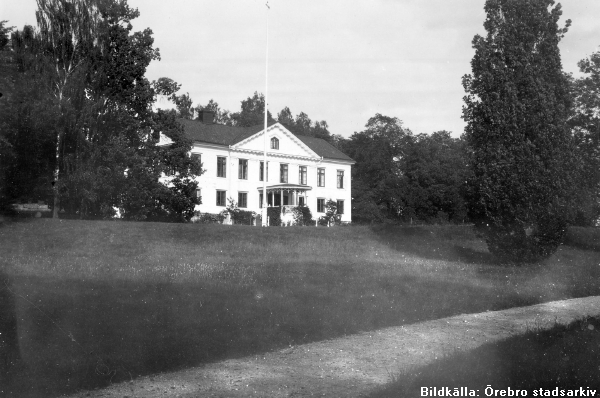Hammarby Mansion

Hammarby
In Nora parish lies a little village called Hammarby, which once was a very successful industrial community.
The successes were traded in to mighty and majestic buildings, including the cow-house which today is proof of the industrial success.
The history of the industrial period dates back to medieval times. The river and the assets in the woods, iron-ore and the water power were important for the work in sawmills, hammer smithy's, foundry's and mills.
The manor house in Hammarby
The manor's origins go back to the 1700s first half of the 1700s. At that time the mansion was owned by noble families and Leijel and Möhlman.
At first, the mansion was the main building with a shingle roof and two wings with turf on the roofs.
At the time of the division of the estate there was a conversion when von Schantz family took possession of the ironworks and the estate. A greenhouse was built at the same time, as they were cultivating different plants from around the world.
In 1832 two brothers, Anders and Per Gustav Wedberg took over the mansion and the top floor was then rebuilt and equipped with a lavish interior. The windows on the building were enlarged to obtain a modern appearance. In addition to this renovation another building behind the main house was built with a connecting path between the two buildings.
When one of the brothers died, his son Carl took over the estate. A lavish improvement of the garden (which is still admired by many) was started. Walkways, fountains, statues, exotic trees and plants were built and planted.
After the golden years the building and its garden have been mostly uninhabited until the company which owned the manor from 1889, decided to sell the property to a private person.
The cow-house
The exact construction-year of the big cow-house is not possible to determine but an a economic map from the early 1860s shows, if the data can be trusted, that the building is from that time.
An inventory of Anders Wedberg (one of the brothers) from 1853 makes clear that the estate had twenty four oxen, five horses, ten cows and a bull, and miscellaneous small animals, suggesting that a cow-house must have been built at that time. The stock was primarily focused on animals that could be used in the work around the estate as draft animals.
The barn for the animals could have been located in today's eastern wing of the cow-house, which is probably the oldest part, based on the building style and materials. In 1864 the estate invested in a new threshing machine to make the threshing more effective.
Hammarby, agricultural and rural property in Nora and Linde parishes, Örebro County, east of the city of Nora, at the water-rich Järleån which there forms a waterfall, which the State bought for 6000,000 kr in 1907 for it's rail operations.
The landed property, which covers 32 101/320 meters acre, was 1907 taxed to 835.400 SEK and the mill, consisting of blast furnace and hearth, manufacturing works, 2 mills, saw, etc., to 145,000 SEK.
Production totaled in 1907 to nearly 4,000 t and 230 ton "martin" castings. The number of workers was 88, 34 for charcoal production (60,000 hl.).
Hammarby origins date back to Gustav I's time, when the so-called king's hammer was built on behalf of the Crown in 1544 and was used until the present mill was built in 1632 by André Dress, one of Louis De Geer's assistants.
His son Otto Dress sold the mill in 1660 to his brother-in-law Jacob Leijel. It passed in 1678 to his son Adam Leijel and 1729 to his nieces, among whom Jacob Möhlman is mentioned as sole owner some time before his death in 1761, after which the same was inherited by niece EvaMaria Petré, who was the widow of hovjunkaren Ludvig von Schantz.
The mill belonged to the von Schantz family generations until the 1830s, when it was bought by brothers P. G. and A. Vedberg. After the latter's death it was owned by the son of C. H. Vedberg until the H. -Yxe limited company was formed (1889).
From "Nordisk familjebok / Uggleupplaga. 10. Gossler - Harris, page 1238.
http://runeberg.org/nfbj/0667.html
|

